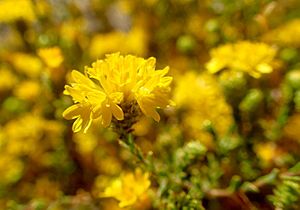Valley lessingia facts for kids
Quick facts for kids Valley lessingia |
|
|---|---|
 |
|
| var. glandulifera | |
| Scientific classification | |
| Kingdom: | |
| (unranked): | |
| (unranked): | |
| (unranked): | |
| Order: | |
| Family: | |
| Tribe: |
Astereae
|
| Genus: | |
| Species: |
L. glandulifera
|
| Binomial name | |
| Lessingia glandulifera |
|
Lessingia glandulifera, also known as the valley lessingia, is a type of flowering plant. It belongs to the daisy family, which includes many well-known flowers like sunflowers and dandelions. This plant is an annual herb, meaning it grows from a seed, flowers, produces seeds, and then dies all within one year.
Contents
What is Valley Lessingia?
The valley lessingia is a plant that can grow to different sizes. It can be as small as 10 centimeters (about 4 inches) or as tall as nearly 80 centimeters (about 31 inches). It can grow straight up or spread out along the ground.
Its Unique Look
This plant can be either smooth with no hairs or very hairy. It also has special parts called glands. These glands are like tiny bumps that can sometimes feel sticky.
- Leaves: The leaves of the valley lessingia are shaped like a spearhead, which is called lance-shaped. They also have small teeth along their edges. The leaves at the bottom of the plant can be up to 11 centimeters long. The leaves higher up on the plant often have these knobby glands on them.
- Flowers: The plant produces special flower structures called flower heads. These are not single flowers but a cluster of many tiny flowers grouped together, like a daisy. Each flower head grows alone at the end of a stem branch.
Inside the Flower Head
Each flower head is surrounded by special leaves called phyllaries. These phyllaries are covered in large glands and sometimes many hairs. The flower head itself is discoid, meaning it's shaped like a disk and doesn't have the typical petal-like ray florets you see on a daisy.
Instead, it has many disc florets. These are small, funnel-shaped flowers that have lobes (parts) that look a bit like petals. The disc florets are usually yellow with brown centers.
How it Makes Seeds
After the flowers bloom, the plant produces fruit. The fruit is a small, dry seed called an achene, similar to a sunflower seed. Each achene has a whitish, feathery structure called a pappus. This pappus helps the seeds float away in the wind, spreading them to new places.
Where Valley Lessingia Grows
The valley lessingia is native to specific regions. You can find it growing naturally in California in the United States and in Baja California in Mexico.
Its Habitat
This plant is quite adaptable and can grow in many different environments. It thrives in various habitats, including:
- Forests
- Deserts
- Coastal areas near the ocean
This ability to grow in different places shows how tough and flexible the valley lessingia is!

